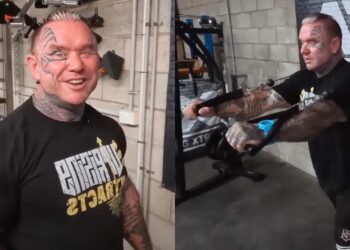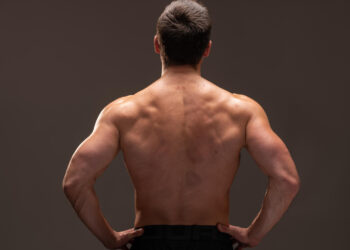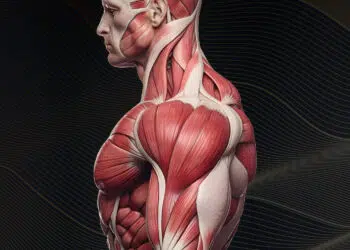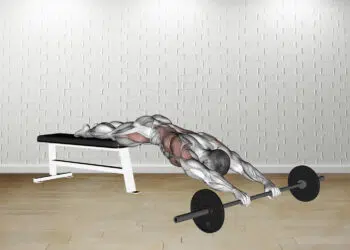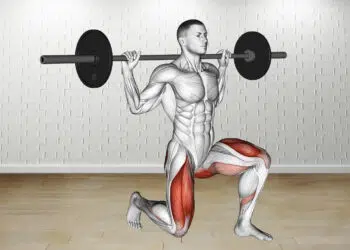It’s no exaggeration to say that the barbell bench press is the most popular chest exercise in the world. Go to any gym any day, and there will probably be a queue for the bench press station.
However, despite this global popularity, in some cases, the bench press is not the best exercise for building a stronger, more muscular chest.
Some lifters simply aren’t built to bench press. Things like a shallow chest, long arms, or narrow shoulders make this classic barbell exercise uncomfortable, and it can even cause joint pain.
Others are bench press non-responders and feel their shoulders and triceps working more than their pecs.
The good news is that you don’t have to bench press if you don’t want to, and there are plenty of exercises you can do instead.
In this article, we explain why and how to do the cable chest press. For some lifters, it’s the perfect alternative to the barbell bench press.
Level Up Your Fitness: Join our 💪 strong community in Fitness Volt Newsletter. Get daily inspiration, expert-backed workouts, nutrition tips, the latest in strength sports, and the support you need to reach your goals. Subscribe for free!
Cable Chest Press – Muscles Worked
The cable chest press is a compound exercise. Compound exercises involve multiple muscles and joints working together. As such, compound exercises are often said to be more functional than their counterparts, which are isolation exercises.
Regardless of where you fall on the whole compound vs. isolation exercise debate, it’s always good to know what muscles you are working when you perform a specific exercise.
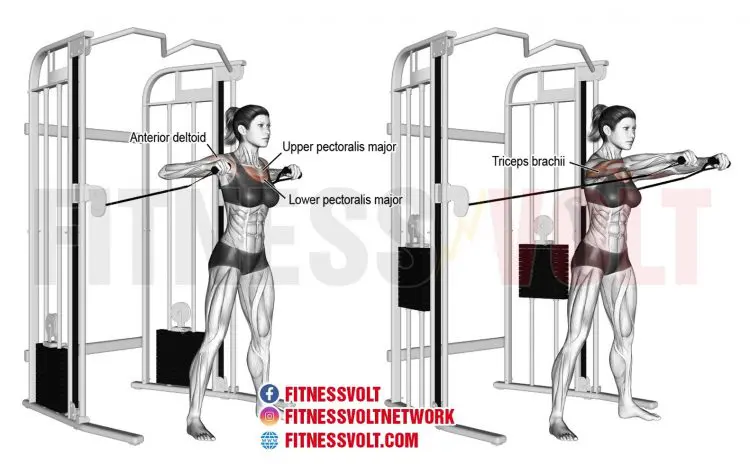
The main muscles involved in cable chest presses are:
Pectoralis major
Known as the pecs for short, these are your most notable chest muscles. The functions of the pecs are horizontal flexion, adduction, and medial rotation of the shoulder joint.
You can target your upper, mid, or lower pecs by altering the angle of your arms. Press upwards to hit your upper pecs, downward to develop your lower pecs, and horizontally to work your mid pecs more.
Deltoids
The deltoids are your primary shoulder muscles. There are three groups of fibers, called heads, that make up the deltoids: anterior (front), medial (middle), and posterior (rear). All three heads work during cable chest presses, but the anterior head is the most active. In contrast, the medial and posterior heads primarily work as stabilizers.
Serratus anterior
Located to the side of your lower pecs, the serratus anterior is so-called because it looks a little like the edge of a serrated knife blade. Because no bench is involved, you’ll have to use this muscle to stabilize your scapulae or shoulder blades and prevent them from moving. In other news, well-developed serratus anterior muscles look very badass!
Rotator cuff
The rotator cuff is a group of four muscles that control and stabilize your shoulders. They’re inferior to your deltoids, which means they are underneath. The rotator cuff muscles are the supraspinatus, infraspinatus, teres minor, and subscapularis, which you can remember with the acronym SITS.
Core
Core is the collective term for the muscles of the midsection, including the rectus abdominis, obliques, transverse abdominis, and erector spinae muscles. These muscles act like a weightlifting belt to protect and stabilize your lumbar spine.
Because you do cable chest presses while standing and without the benefit of a bench, your core must contract and prevent unwanted movement. Not engaging your core means your body may move backward as you press your arms forward!
Triceps brachii
Located on the back of your upper arms and known as the triceps for short, this muscle is responsible for extending your elbow. Many people feel cable chest presses as much in their triceps as they do their chests.
How to Do the Cable Chest Press
Get more from cable chest presses while keeping your risk of injury to a minimum by following these guidelines:
- Adjust the handles on a cable crossover or dual cable machine to about chest height.
- Take a handle in each hand, step forward to tension the cables, and adopt a staggered stance for balance.
- Pull your hands into the sides of your chest, palms facing the floor or inward as preferred.
- Brace your core and pull your shoulders down and back.
- Press your hands forward and together, so they meet in front of your chest. Your arms should be straight but not locked.
- Return to the starting position and repeat.
Tips:
- If you have to lean forward to maintain your balance, you’re trying to lift too much weight, or your core is weak. Make adjustments as necessary.
- Keep your chest up to maximize pec engagement.
- Protract your shoulders slightly at the top of each rep to maximally engage your pec and serratus anterior muscles.
- You can also do this exercise with resistance bands – like this:
Cable Chest Press Benefits and Drawbacks
Not sure if the cable chest press deserves a place in your upper body workouts? Consider these benefits and then decide!
A shoulder-friendly exercise
The barbell bench press is notoriously hard on the shoulder joint. In fact, many lifters quit the bench press and do floor presses, push-ups, and chest presses instead. And now you can add another exercise to your shoulder-friendly chest workout – the cable chest press.
With cable chest presses, your shoulders and scapulae are free to move naturally and independently. This exercise is well-tolerated by lifters with existing or past shoulder pain.
If bench presses hurt your banged-up shoulders, cable chest presses could be the exercise that lets you continue training your chest without more pain.
Perfect for muscle-building drop sets
Drop sets are a training method that allows you to push your muscles beyond failure. With a drop set, you rep out until you are unable to perform any more reps, reduce (or drop) the weight by 10-15%, and then rep out again. You can lower the weight one time or more depending on how hard you want to train.
Cable chest presses are great for drop sets, as you can simply whip out the weight pins and reinsert them in seconds. You can’t do that with bench presses!
Workout variety
Your body is incredibly adaptive. As such, doing the same exercises or workout for too long can cause your gains to stall. Having plenty of exercises to choose from mean that you’re less likely to get stuck in a workout rut as you’ll always have different options available.
So, even if you don’t want to do cable chest presses in your current workout, you can include them in your next one to keep your chest growing and improving.
While the cable chest press is a mostly beneficial exercise, there are also a couple of drawbacks to consider:
Your performance is limited by the strength of your core
When you do barbell or dumbbell bench presses or use a regular chest press machine, your back is supported by a sturdy bench. This leaves you free to focus on lifting and lowering the weight.
With cable chest presses, you ARE the bench, and your core strength, or lack thereof, will determine how much weight you can use. If your core is weak, you won’t be able to lift as much weight, or your set could come to an early end, leaving your pecs unstimulated.
Level Up Your Fitness: Join our 💪 strong community in Fitness Volt Newsletter. Get daily inspiration, expert-backed workouts, nutrition tips, the latest in strength sports, and the support you need to reach your goals. Subscribe for free!
For this reason, most bodybuilders use the cable chest press as a secondary exercise, performing it only after they’ve fatigued their pecs with a more stable, supported chest exercise.
Great for hypertrophy, but not so good for developing strength
Leading on from the point above, cable chest presses do not lend themselves to heavy weights and low reps, i.e., 1-5 per set, which is what works best for building maximal strength. So, while it’s an effective exercise for creating muscle tension and metabolic stress for hypertrophy, it’s not so good for improving your upper body pushing performance.
You WILL get stronger doing cable chest presses, but not as much as you can with freeweights or regular resistance training machines.
7 Cable Chest Press Variations and Alternatives
The cable chest press is a highly effective upper-body pushing exercise, but that doesn’t mean you need to do it all the time. There are several variations and alternatives you can use to keep your workouts productive and interesting:
1. Single-arm cable chest press
No dual cable machine at your gym? No problem! You can do the single-arm chest press using any adjustable pulley. As an added benefit, this exercise increases core activation, as you’ll need to work extra hard to prevent your torso from twisting.
Steps:
- Adjust the cable machine to around mid-chest height and attach a D-shaped handle to the pulley.
- Hold the handle, so the cable runs outside your arm. Step forward to tension the cable and adopt a split stance for stability. Brace your core.
- Keeping your hips and shoulders square, push your arm forward until it’s straight but not locked.
- Bend your arm, bring your hand back to your shoulder, and repeat.
Muscles Targeted:
- Primary: Pectoralis major, triceps, core.
- Secondary: Deltoids.
Benefits:
- Good for fixing left-to-right imbalances.
- A very functional pressing exercise that replicates punching and throwing.
- A great chest AND core workout.
Tips:
- Vary the angle of your arm to hit different pec fibers, e.g., press upward to target your upper chest.
- Keep your upper arm close to your side and then flare your elbow as you push away to mimic the natural movement of your shoulder.
- Use your non-working arm for balance by pulling it in as you extend your opposite arm and vice versa.
2. Cable bench press
For many people, standing cable chest presses feel awkward, or they find their inability to lift heavy weights frustrating. The cable bench press often feels more natural, and using a bench means you don’t need to worry so much about your core strength limiting how much weight you can lift.
Steps:
- Place a flat bench in the middle of a cable crossover machine. Attach D-shaped handles to the bottom pulleys.
- Sit on the end of the bench and take a handle in each hand.
- Lie back and pull the handles into the sides of your chest.
- Next, press your arms up and inward, so your hands meet above your chest.
- Lower the handles back to your shoulders and repeat.
Muscles Targeted:
- Primary: Pectoralis major, triceps.
- Secondary: Deltoids.
Benefits:
- Lift more weight than the standing cable chest press.
- Less core engagement so you can focus more on your pecs.
- A good way to bench press when you have no spotters.
Tips:
- Use a flat, incline, or decline bench as preferred.
- Press inward as well as upward to maximize pec engagement.
- You can also do this exercise one-handed, i.e., single-arm cable bench press.
3. Close grip dumbbell bench press
Also known as the squeeze press or hex dumbbell bench press, this is an excellent alternative to the barbell bench press and feels a lot like doing cable chest presses. With this exercise, you press the dumbbells inward as well as upward, which creates an intense pec contraction. This is also a very shoulder-friendly exercise. Try it; you’re going to love it!
Steps:
- Lie on a bench with a dumbbell in each hand. Press the weights up to arm’s length, and then push your arms inward so the weights are squeezed together.
- Bend your arms and lower the dumbbells to the center of your chest. Tuck your elbows into your sides.
- Press the weights back up and repeat.
Muscles Targeted:
- Primary: Pectoralis major, deltoids.
- Secondary: Triceps.
Benefits:
- A great exercise that doesn’t require heavy weights.
- Very shoulder-friendly.
- An excellent chest workout finisher.
Tips:
- Maintain constant inward pressure on the dumbbells.
- Do this exercise on a flat, incline, or decline bench as preferred.
- You can also do this exercise by pressing your palms against a weight plate, like this:
4. Gymnastic ring push-up
Gymnastic rings can be used to replicate many freeweight and machine exercises. That said, sometimes you’ll need to rethink the movement to come up with a suitable alternative for the exercise you have in mind. For example, ring push-ups and cable chest presses don’t look particularly similar but, in fact, are very closely related. If lack of equipment means you cannot do cable chest presses, try gymnastic ring push-ups.
Steps:
- Adjust the height of your rings to between ankle and knee height. Kneel behind them and hold the bottom of the rings so your palms are facing inward. The straps should be vertical.
- Keeping your arms straight, pull your shoulders down and back, and brace your abs. Tuck your elbows into your sides.
- Extend your legs and support your weight on your hands and feet only.
- Bend your arms and lower your chest down between your rings. The rings should be just outside your shoulders.
- Push yourself back up to full arm extension and repeat.
Muscles Targeted:
- Primary: Pectoralis major, deltoids, triceps.
- Secondary: Core.
Benefits:
- Less equipment required – you can do this exercise at home or anywhere else you can hang some rings.
- An excellent progression from regular push-ups.
- A prerequisite for gymnastic ring dips.
Tips:
- Make this exercise harder by raising your feet or wearing a weighted vest.
- Make it easier by shortening the straps and raising the height of the rings. Alternatively, you can bend your legs and rest on your knees.
- You can also do this exercise with a suspension trainer, e.g., a TRX or similar.
5. Cable crossover
The cable crossover is a classic chest exercise. Like the cable chest press, it’s a machine version of a well-known freeweight movement – in this case, dumbbell flyes. While there is nothing wrong with standard dumbbell flyes, cable crossovers keep your muscles under tension for longer, making them a potentially better muscle-building exercise.
Steps:
- Set the cable pulleys at their highest setting and attach the D-handle handles.
- Hold the handles with an overhand grip.
- Take a step forward to tension the cables and adopt a staggered stance. Lean forward slightly and push out your chest.
- Your arms should be perpendicular to your body, elbows extended and rigid but not locked.
- While maintaining the slight bend in your elbows, bring your arms in front of your body.
- Cross your wrists at the bottom of each rep and squeeze your pecs as hard as possible.
- Slowly return to the starting position, get a stretch in your chest, and repeat.
Muscles Targeted:
- Primary: Pectorals major.
- Secondary: Deltoids.
Benefits:
- A great way to isolate your pecs and avoid using your triceps.
- An excellent exercise for the inner chest.
- A very shoulder-friendly movement.
Tips:
- Adjust the angle of your arms to hit different regions of your chest, i.e., from high to low to work your lower chest, horizontal to work your mid-chest, and low to high to target your upper chest.
- Imagine you are hugging a tree to get a better feel for this exercise.
- Avoid the temptation to lean forward too much and turn this into a bent-over pressing exercise.
6. Dumbbell/cable hybrid press
Can’t choose between dumbbell and cable chest presses? Then do them both! This exercise does take a little setting up, but you’ll be rewarded with an excellent chest workout that hits your pecs in a highly unusual way. If you have the means to try this hybrid exercise, you should do like Nike says and JUST DO IT!
Steps:
- Place a bench in the middle of a cable crossover machine. Attach cuffs to the lowermost cables. Sit on the bench and put the cuffs around your wrists.
- Next, hold a dumbbell in each hand and lie back. Hold the weights down by your shoulders, palms facing inward.
- From here, press the weights up and over your chest. The weights should lightly touch at the top of each rep.
- Lower the weights down and back to your shoulders and repeat.
Muscles Targeted:
- Primary: Pectoralis major, triceps.
- Secondary: Deltoids.
Benefits:
- A very unusual chest exercise, so it’s good for adding variety to your workouts.
- Effective even when you use lighter than usual weights.
- Combine two exercises in one – cable flyes and dumbbell chest presses.
Tips:
- You can do this exercise on an incline bench to hit your upper chest more.
- Use enough weight on the cable machine so that you have to actively press your arms inwards to overcome the resistance.
- Squeeze your arms together at the top of each rep to maximize pec engagement.
7. Medicine ball push-up
One of the reasons that cable chest presses are so effective is that you have to press your arms inward at the mid-point of each rep. This action increases muscle activation, especially in the inner pecs. Doing push-ups on a medicine ball has a similar effect, but with minimal equipment required, you’ll be able to do this exercise at home.
Steps:
- Place a firm medicine ball on the floor. Squat down and place your hands on the sides of the ball.
- Walk your feet out and back, so your arms, legs, and body are straight. Brace your core.
- Bend your arms and lower your chest down to touch the ball.
- Push yourself back up and repeat.
Muscles Targeted:
- Primary: Pectoralis major, triceps.
- Secondary: Deltoids.
Benefits:
- An excellent progression from regular push-ups.
- Creates an intense inner-pec and triceps contraction.
- Good for developing a stronger core and better balance.
Tips:
- Bend your legs and rest on your knees to make this exercise easier.
- Use gym chalk to prevent your hands from slipping off the ball.
- Wear a weight vest or raise your feet to make this exercise more challenging.
Cable Chest Press FAQs
Do you have a question about cable chest presses or pec training in general? That’s okay because we’ve got the answers!
1. Is the cable chest press better than the bench press?
Whenever you compare two exercises to determine which one is best, the answer is almost always – it depends on you! There are no bad exercises, but the best usually depends on your needs and goals.
For example, the barbell bench press is your best choice if you’re a powerlifter or want to get really strong. It’s the exercise with the potential to build the most strength.
But, if you’ve got banged-up shoulders, are more interested in hypertrophy than pure strength, or simply don’t enjoy bench pressing, the cable chest press is a great alternative.
So, choose the exercise that best matches your goals or, if you can’t decide between them, do both and enjoy all the benefits on offer.
2. What is the best repetition range for cable chest presses?
It would be a mistake to do cable chest presses with a heavy weight and for low reps. Because you’re standing and have no bench to support you, very heavy weights will push you backward and off balance, making the exercise not just less effective but potentially impossible to perform properly.
So, choose a light to moderate weight and do medium to high reps. 8-20 is a good range for most lifters. Just make sure you take your sets to within a couple of reps of failure to trigger hypertrophy. Easy sets don’t build muscle!
3. Is the cable chest press a safe exercise?
Cable chest presses are a very safe exercise. Because your shoulders and scapulae are free to move naturally, there is much less stress on your joints than barbell and dumbbell bench presses. Also, if you fail mid-rep, there is no heavy bar to come crashing down across your chest.
So, yes – cable chest presses are very safe, especially when compared to regular barbell and dumbbell bench presses.
4. How many times per week should I train my chest?
It’s generally best to train each muscle group twice per week. Have a few rest days between workouts for the same body part to allow time for rest and recovery, e.g., Monday and Thursday.
You can get good results training less frequently, i.e., weekly, but you’ll need to do a lot of sets to make your workout effective. Doing two workouts per week means you can do fewer sets and train harder, which should produce superior results.
5. Got a good twice-a-week chest workout for me to try?
Sure do! This two-day chest workout combines classic free weight exercises with some challenging cable and bodyweight movements to hit your pecs from all the angles. Do it for the next 6-8 weeks, and your chest will blow up!
The Pectoral Split – Two Workouts Per Week for Perfect Pecs
Wrapping Up
The barbell bench press might be the world’s favorite chest exercise, but that doesn’t mean it’s the best option for every lifter. For some, the bench press is more of a shoulder wrecker than a chest builder. Other people are bench press non-responders.
The good news is that there is no bodybuilding rule that says you HAVE to bench press. In fact, some coaches like the legendary Iron Guru Vince Gironda didn’t rate it as a chest builder.
So, whether you need a break from bench presses or just don’t get on with them, give the cable chest press a try. You’ve got nothing to lose but your shoulder aches and pains and everything to gain!
Interested in measuring your progress? Check out our strength standards for Bench Press, Push Ups, Floor Press, and more.



